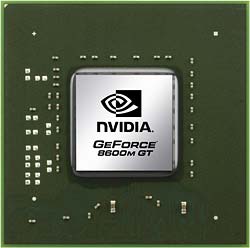NVIDIA GeForce 8M Series Preview
Introduction & Specifications

The GeForce 8M Series offers many of the same features as NVIDIA's desktop GeForce 8 series. The initial line-up of GeForce 8M series GPUs contain 289 million transistors and just like its desktop counterparts, the GeForce 8M will offer full DX10 support, hardware HD video decoding courtesy of NVIDIA's 2nd generation PureVideo technology, and a fully unified shader architecture. We've already talked at great length about the GeForce 8 series' architectural features and benefits in the past, so we won't go into detail again here.
|
|
NVIDIA GeForce 8M Series |
| Features & Specifications |
|
NVIDIA unified architecture: Fully unified shader core dynamically allocates processing power to geometry, vertex, physics, or pixel shading operations, delivering up to 2x the gaming performance of prior generation GPUs. GigaThread Technology:
Full Microsoft DirectX 10 Support:
NVIDIA Lumenex Engine:
128-bit floating point High Dynamic-Range (HDR):
NVIDIA Quantum Effects Technology:
NVIDIA ForceWare Unified Driver Architecture (UDA):
OpenGL 2.0 Optimizations and Support:
NVIDIA nView Multi-Display Technology:
PCI Express Support:
Dual 400MHz RAMDACs:
Dual Dual-link DVI Support:
Built for Microsoft Windows Vista:
NVIDIA PureVideo HD Technology:
Discrete, Programmable Video Processor:
HDCP Capable:
Spatial-Temporal De-Interlacing:
|
Hardware Decode Acceleration:
High-Quality Scaling:
Inverse Telecine (3:2 & 2:2 Pulldown Correction):
Bad Edit Correction:
Video Color Correction:
Integrated SD and HD TV Output:
Video Post-Processing:
|
As it is a mobile part, the GeForce 8M employs significantly more sophisticated power management features than its desktop counterparts. To realize this, the GeForce 8M series is equipped with NVIDIA's seventh generation PowerMizer power management technology. One of PowerMizer's more interesting features is the ability to allow the user to control system performance and battery consumption based on their needs. New in the seventh generation is support for Vista's power management features, like activity-based switching and adaptive clocking which dynamically adjusts GPU power and active features based on current operational needs, without any user intervention. PowerMizer 7.0 also implements SmartDimmer 2.0, which dynamically modulates backlight lamp power. The second generation of SmartDimmer offers more efficient power usage and smoother transitions than before.








